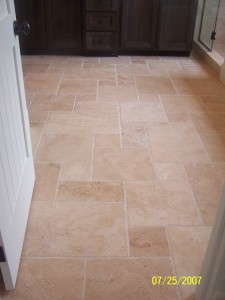Prior to this, polished marble was the primary stone utilized in interior areas. Today, numerous stones are used. What type of natural stone do you have inside your home, on your patios, entry’s or in your exterior landscaping? Stone cladding today ranges from the very dense, low porosity stones such as granite to high porosity (very absorbent) stones such as sandstone and travertine.
Surface textures also vary, ranging from very rough, textured surfaces such as cleft slate and flamed-finished granite to polished surfaces often found on marble and granite surfaces.
Although natural stone provides an excellent upgrade from many of today’s synthetic alternatives, it must still be recognized that it is neither maintenance free or stain proof.
Grout, even latex-modified, is also very porous and subject to sub-surface staining if not properly protected and maintained.
Here are some excellent tips that will help insure the ongoing beauty, long life, cleanliness and slip resistance of your stone installation:
Do: Seal your stone and grout installation to improve the stain resistance and ease the ongoing maintenance. It is very important that the proper sealer be used based on the type of stone, surface finish and location.
A good rule of thumb is that with denser stone, including polished surfaces, is that only penetrating–type sealers should be used. If you have a stone with a very porous (absorbent) or textured surface such as slate or sandstone, then you have an option of using a “coating” or surface sealer that will generally provide a degree of surface sheen or a penetrating-type sealer that will leave a completely natural look. Be careful when selecting coating-type sealers on exterior areas as many of the coating-type sealers currently available do not work well in exposed exterior environments.
Don’t: Allow liquid contaminants to stand indefinitely on stone and grout surfaces, even if they are sealed. It is important to remove liquid contaminants as soon as possible. They will very quickly penetrate into unsealed stone and grout surfaces, making them difficult to extract, and eventually seep into even sealed surfaces if allowed to dwell for extended periods of time. A sealer should be viewed as providing reaction time to remove the contaminant before it penetrates and stains the stone or grout.
Don’t: Directly wipe a liquid contaminant off the stone or grout surface. This will simply cause the stain to be spread over a larger area, and even drive the contaminant deeper into the stone or grout, especially if unsealed.
Do: Quickly utilize an absorbent paper towel or rag to blot up any liquid contaminant remaining wet on the surface before scrubbing the surface with a proper cleaner.
Don’t: Use acidic cleaners for routine stone maintenance. Although many stones are acid resistant, there are many stones (most noteworthy – Marble), which are sensitive to acids. Even a light solution of vinegar and water will quickly etch and dull polished marble surfaces. It is also important to note that acidic cleaners do not function as degreasers, but work by chemically attacking cement and calcium found in grout and some varieties of stone, thus damaging the structural integrity of the grout and stone.
Do: Use neutral PH cleaners for everyday routine cleaning of stone and grout surfaces. In situations where periodic heavy duty cleaning is needed, use an alkaline (high PH) cleaner. These are excellent degreasers, working well on grout and most stone surfaces without chemically damaging these surfaces. It is recommended that whatever cleaner is used on fine polished marble, that it is always first tested to insure that it does not dull the polished surface. Don’t: Clean textured stone surfaces and grout using only a mop. Highly textured or uneven surfaces such a flamed granite, slate and sanded grout is rough finished and tends to grip and hold surface contaminants. A simple moping is not going to create sufficient surface agitation to release these clinging contaminants.
Do: After applying a neutral PH or high alkaline cleaner, utilize a scrub brush to create sufficient surface agitation to release the surface contaminants so they can be easily removed in the rinsing process. Don’t: Wet mop polished stone surfaces, allowing the polished surface to surface dry as the water evaporates. This will allow for eventual mineral buildup to occur which will dull high polished finishes. Do: Use absorbent paper or cotton towels to polish dry any water on the polished surface. This will eliminate the dulling mineral deposits that would be left behind if the water is left to naturally evaporate. This is also important in wet areas such as showers, where polished stone surfaces should be towel dried after use so as to eliminate eventual buildup of mineral-hard water deposits.
Don’t: Just pick up any cleaner from your local grocery stone and use to clean your stone and grout. You would be surprised how many cleaners contain at least trace amounts of acid that can cause quick or eventual damage to fine stone and grout. Most stone and ceramic tile outlets carry cleaners that are specially designed to properly care for these fine surfaces.
Do: Contact the product manufacturer if you have any questions about their product and its intended use. Manufacturers of these products should have toll free numbers and would encourage phone inquiries should there be any questions about their products.For example, Aqua Mix Inc, a specialist manufacturer of sealers, cleaners and “problem solvers” for stone, tile and grout encourages all questions be addressed to their “Technical Service Hotline” at 1-800-366-6877.


